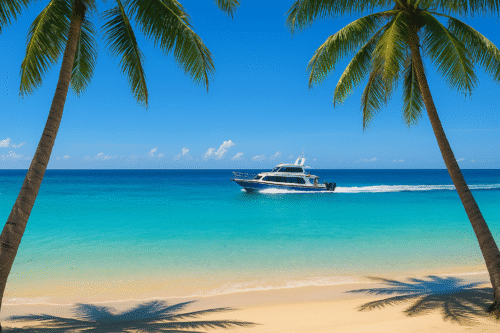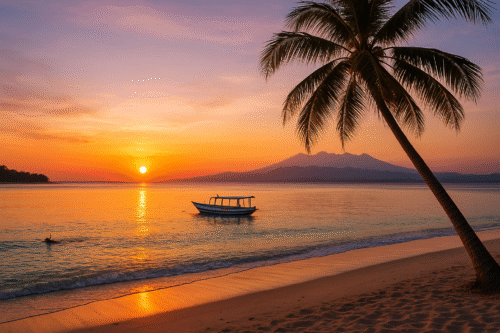The Gili Islands – Gili Trawangan, Gili Meno and Gili Air – enjoy a tropical climate all year round, with warm temperatures, plenty of sunshine and two main seasons: the dry season and the rainy season.
Understanding the weather patterns helps travellers plan the best time for beach activities, snorkeling, diving or a peaceful island escape.
Average Climate Year-Round
The Gilis have consistently warm temperatures throughout the year, typically between 27 °C and 32 °C (80 °F – 90 °F) during the day and rarely dropping below 24 °C (75 °F) at night.
The water temperature stays pleasant for swimming and diving, averaging 27 °C to 29 °C (80 °F – 84 °F) all year, which makes the islands a good beach destination any month.
Humidity is usually high, between 70–85 %, which can make the air feel hotter, especially at midday.
Sunrise on the Gilis is around 6:00–6:30 AM, and sunset around 6:00–6:30 PM, with only slight changes across the year because of the islands’ equatorial location.
The Dry Season: May to October
The dry season generally lasts from May to October.
During these months the islands see plenty of sunshine, low rainfall and lower humidity, making it the most popular time for tourists.
The sea is usually calm and clear, which is excellent for snorkeling, diving and boat trips.
Average daytime temperatures range from 28 °C to 31 °C (82 °F – 88 °F), and rain is rare or limited to short light showers.
July, August and early September are the peak months with the busiest beaches and higher accommodation demand, so booking ahead is recommended.
The Rainy Season: November to April
The rainy season typically starts in November and runs through April.
Rain usually falls in short tropical showers or thunderstorms, often in the late afternoon or evening, rather than all-day rain.
Daytime temperatures remain warm, around 29 °C to 32 °C (84 °F – 90 °F), and the islands stay lush and green.
Humidity rises during these months, and seas can become choppier, sometimes leading to fast-boat delays or cancellations, especially in December, January and February when rainfall peaks.
Despite the wetter weather, mornings are often sunny, and some travellers enjoy the quieter atmosphere and lower prices.
Best Time for Snorkeling and Diving
Underwater visibility around the Gilis is best in the dry season, especially from June to October, when the water is clearest and calm.
However, diving and snorkeling are possible year-round thanks to the consistently warm water temperature.
During the rainy months, visibility may be slightly reduced after heavy rains or storms.
Sun, UV Index and Heat Precautions
The UV index is high throughout the year, often rated 10 or higher at midday.
Visitors should wear reef-safe sunscreen, hats, sunglasses and lightweight long sleeves to avoid sunburn.
Hydration is essential in the tropical heat, especially for children and during outdoor activities like cycling or beach walks.
Packing Tips for the Seasons
For the dry season, bring light cotton clothes, swimwear, sandals and plenty of sun protection.
For the rainy season, pack a light rain jacket or poncho, quick-drying clothes and waterproof cases for phones or cameras.
A travel umbrella can be useful for brief showers, and sandals or water-resistant shoes help on wet sandy paths.
The weather on the Gili Islands is warm and beach-friendly all year, with a sunnier, drier period from May to October and a wetter but still warm season from November to April.
By choosing the right season and packing accordingly, visitors can make the most of the islands’ turquoise waters, soft beaches and breathtaking sunsets, no matter when they choose to come.





